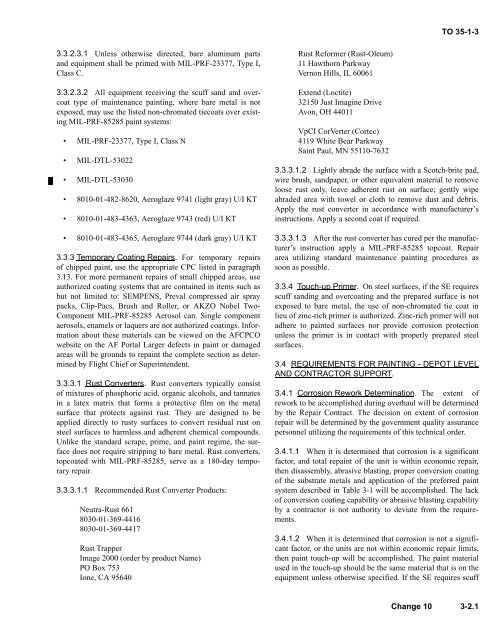TO 35-1-3 - Robins Air Force Base
TO 35-1-3 - Robins Air Force Base
TO 35-1-3 - Robins Air Force Base
You also want an ePaper? Increase the reach of your titles
YUMPU automatically turns print PDFs into web optimized ePapers that Google loves.
<strong>TO</strong> <strong>35</strong>-1-3<br />
3.3.2.3.1 Unless otherwise directed, bare aluminum parts<br />
and equipment shall be primed with MIL-PRF-23377, Type I,<br />
Class C.<br />
3.3.2.3.2 All equipment receiving the scuff sand and overcoat<br />
type of maintenance painting, where bare metal is not<br />
exposed, may use the listed non-chromated tiecoats over existing<br />
MIL-PRF-85285 paint systems:<br />
• MIL-PRF-23377, Type I, Class N<br />
• MIL-DTL-53022<br />
• MIL-DTL-53030<br />
• 8010-01-482-8620, Aeroglaze 9741 (light gray) U/I KT<br />
• 8010-01-483-4363, Aeroglaze 9743 (red) U/I KT<br />
• 8010-01-483-4365, Aeroglaze 9744 (dark gray) U/I KT<br />
3.3.3 Temporary Coating Repairs. For temporary repairs<br />
of chipped paint, use the appropriate CPC listed in paragraph<br />
3.13. For more permanent repairs of small chipped areas, use<br />
authorized coating systems that are contained in items such as<br />
but not limited to: SEMPENS, Preval compressed air spray<br />
packs, Clip-Pacs, Brush and Roller, or AKZO Nobel Two-<br />
Component MIL-PRF-85285 Aerosol can. Single component<br />
aerosols, enamels or laquers are not authorized coatings. Information<br />
about these materials can be viewed on the AFCPCO<br />
website on the AF Portal Larger defects in paint or damaged<br />
areas will be grounds to repaint the complete section as determined<br />
by Flight Chief or Superintendent.<br />
3.3.3.1 Rust Converters. Rust converters typically consist<br />
of mixtures of phosphoric acid, organic alcohols, and tannates<br />
in a latex matrix that forms a protective film on the metal<br />
surface that protects against rust. They are designed to be<br />
applied directly to rusty surfaces to convert residual rust on<br />
steel surfaces to harmless and adherent chemical compounds.<br />
Unlike the standard scrape, prime, and paint regime, the surface<br />
does not require stripping to bare metal. Rust converters,<br />
topcoated with MIL-PRF-85285, serve as a 180-day temporary<br />
repair.<br />
3.3.3.1.1 Recommended Rust Converter Products:<br />
Neutra-Rust 661<br />
8030-01-369-4416<br />
8030-01-369-4417<br />
Rust Trapper<br />
Image 2000 (order by product Name)<br />
PO Box 753<br />
Ione, CA 95640<br />
Rust Reformer (Rust-Oleum)<br />
11 Hawthorn Parkway<br />
Vernon Hills, IL 60061<br />
Extend (Loctite)<br />
32150 Just Imagine Drive<br />
Avon, OH 44011<br />
VpCI CorVerter (Cortec)<br />
4119 White Bear Parkway<br />
Saint Paul, MN 55110-7632<br />
3.3.3.1.2 Lightly abrade the surface with a Scotch-brite pad,<br />
wire brush, sandpaper, or other equivalent material to remove<br />
loose rust only, leave adherent rust on surface; gently wipe<br />
abraded area with towel or cloth to remove dust and debris.<br />
Apply the rust converter in accordance with manufacturer’s<br />
instructions. Apply a second coat if required.<br />
3.3.3.1.3 After the rust converter has cured per the manufacturer’s<br />
instruction apply a MIL-PRF-85285 topcoat. Repair<br />
area utilizing standard maintenance painting procedures as<br />
soon as possible.<br />
3.3.4 Touch-up Primer. On steel surfaces, if the SE requires<br />
scuff sanding and overcoating and the prepared surface is not<br />
exposed to bare metal, the use of non-chromated tie coat in<br />
lieu of zinc-rich primer is authorized. Zinc-rich primer will not<br />
adhere to painted surfaces nor provide corrosion protection<br />
unless the primer is in contact with properly prepared steel<br />
surfaces.<br />
3.4 REQUIREMENTS FOR PAINTING - DEPOT LEVEL<br />
AND CONTRAC<strong>TO</strong>R SUPPORT.<br />
3.4.1 Corrosion Rework Determination. The extent of<br />
rework to be accomplished during overhaul will be determined<br />
by the Repair Contract. The decision on extent of corrosion<br />
repair will be determined by the government quality assurance<br />
personnel utilizing the requirements of this technical order.<br />
3.4.1.1 When it is determined that corrosion is a significant<br />
factor, and total repaint of the unit is within economic repair,<br />
then disassembly, abrasive blasting, proper conversion coating<br />
of the substrate metals and application of the preferred paint<br />
system described in Table 3-1 will be accomplished. The lack<br />
of conversion coating capability or abrasive blasting capability<br />
by a contractor is not authority to deviate from the requirements.<br />
3.4.1.2 When it is determined that corrosion is not a significant<br />
factor, or the units are not within economic repair limits,<br />
then paint touch-up will be accomplished. The paint material<br />
used in the touch-up should be the same material that is on the<br />
equipment unless otherwise specified. If the SE requires scuff<br />
Change 10 3-2.1
















